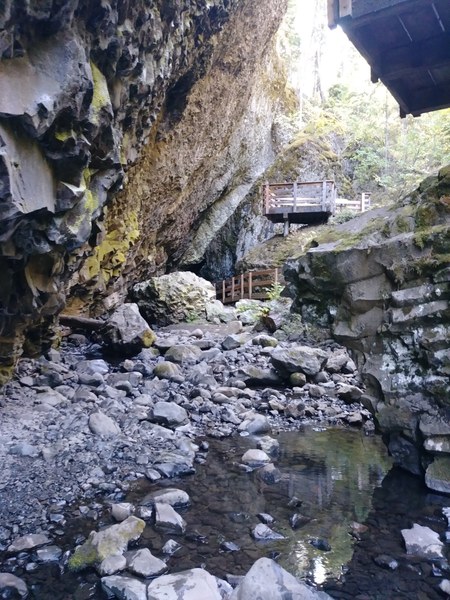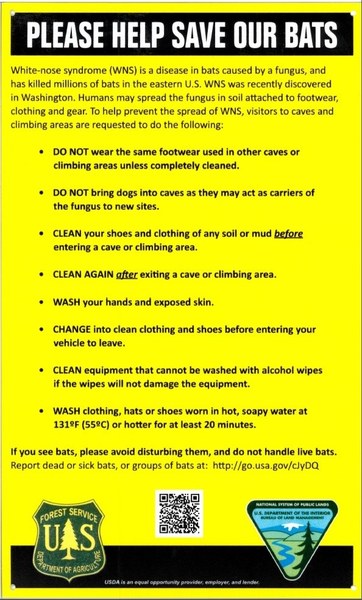
The Okanogan-Wenatchee National Forest is a large, diverse landscape, encompassing over 4 million acres along the eastern slopes of the Cascade Range. It's home to the one and only Boulder Cave located east of Mt Rainier National Park.
Trip Facts
Location: Chinook Pass - Hwy 410 - Okanogan-Wenatchee National Forest
Length: 2.0 miles, roundtrip
Elevation Gain: 300 ft.
Highest Point: 2700 ft.
Hours: This day use site is open 8am to 8pm; the main access gate is closed at 8pm each night.
Pass: Northwest Forest Pass
Boulder Cave Bats
What makes this cave unique is not only the geology of the area, but the bats that inhabit the cave itself.
Boulder Cave was created when Devil Creek cut through the Miocene Yakima Basalt volcanic flow ten to fifteen million years ago. Devil Creek undercut the fractured basalt, causing the canyon wall to slide down, bridging the creek and thus forming Boulder Cave.
During the 1930s, the Civilian Conservation Corps built the trails up to Boulder Cave. The trail begins at the picnic area and climbs gradually for ¾ of a mile before descending into the cave. The cave trail itself is roughly a 400 foot rocky trail alongside Devil Creek.
 Stairs leading out of Boulder Cave. Photo by Regina Robinson.
Stairs leading out of Boulder Cave. Photo by Regina Robinson.
Even before the trail was built, the cave attracted many visitors, causing the resident bat populations to decline in the 1920s; bats are extremely sensitive to human-caused disturbances.
It's important not to disturb hibernating bats. If a bat rouses early from hibernation, it must use its fat reserves to increase its body temperature. A single disturbance costs a bat as much energy as it would normally expend in two to three weeks hibernating. As a result, if disturbed multiple times, hibernating bats may starve to death before spring.
Therefore, bat roosts which experience repeated human visitation frequently show severe population declines and abandonment.
Bats are critical to our environment because they consume more than their body weight in mosquitoes and other flying insects to prepare for pregnancy and hibernation.
White-nose syndrome is a fungal disease caused by “Pseudogymnoascus destructans,” a cold-loving fungus that is fatal to bat colonies. The disease has been estimated to have killed millions of bats in North America since 2006, and it's very deadly for bats in hibernation.
To protect the caves containing wintering bat colonies, visitation is closed during the fall and winter months. Visitation is open from April or May through October 1. The longer closure will help prevent the spread of white-nose syndrome and decrease human disturbances to the three species of hibernating bats who call this cave home. This includes the rare Pacific Western “Townsend” big eared bats. There are only a few colonies known to exist in the Cascades. If white-nose syndrome were to reach Boulder Cave, it would have the potential to wipe out the entire bat population. At this time, white-nose syndrome has not reached Boulder Cave.
 Entrance to Boulder Cave. Photo by Regina Robinson.
Entrance to Boulder Cave. Photo by Regina Robinson.
Be Prepared
Protect the Bats
- Wipe boots and shoes off at entrance of the cave
- Pointing headlamps/flashlights at the ceiling or the walls of the cave will disturb the bats
- Keep voices low
- No dogs permitted in the cave
What to Bring
- Headlamp or flashlight
- Sturdy boots
- Extra clothing as the cave is damp and cool
For More Information
- Okanogan-Wenatchee National Forest Maps and Publications
- Learn more about white-nose syndrome
- Living with bats in Washington State
Directions
From Enumclaw, head east on State Route 410 to Chinook Pass, continuing east to The Boulder Cave Natural Area located near milepost marker 95 on State Route 410, approximately 32 miles west of Naches. There is a sign on the road pointing toward the Boulder Cave Day Use Site. Turn right onto Forest Service Road 1706, cross over the bridge, and come to a road junction. Turn right, then follow signs to Boulder Cave (about 1.4 miles from the bridge).

 Regina Robinson
Regina Robinson